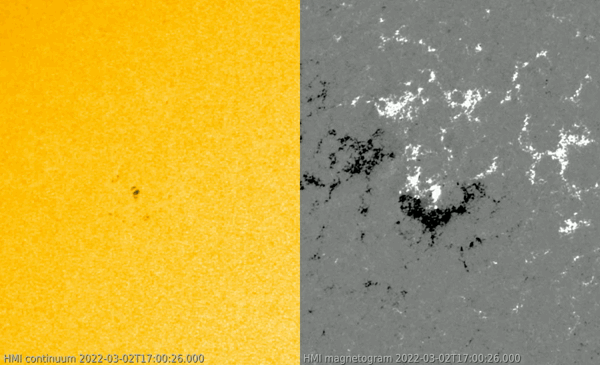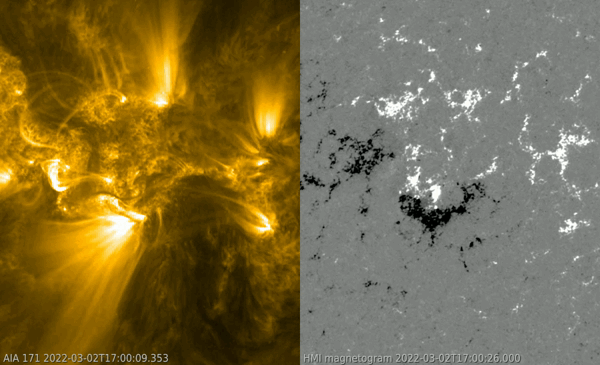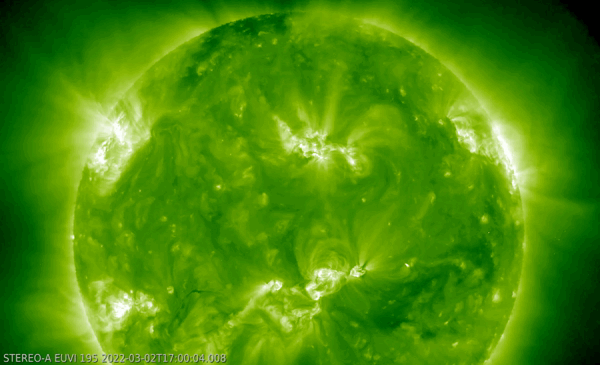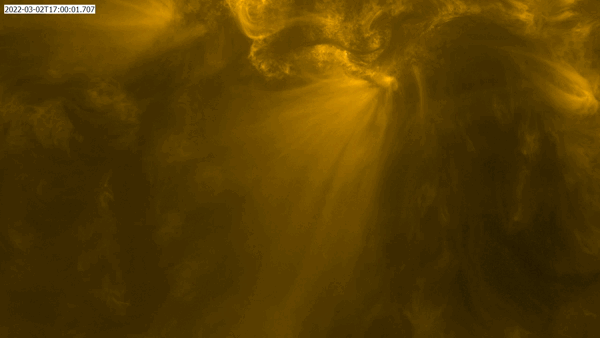An interesting solar eruption was observed by numerous solar satellites on 2 March. The M2 flare peaked at 17:39UTC in the small sunspot region NOAA 2958. Statistically, this kind of sunspot groups has only a few percent chance to produce an M-class flare (see the STCE's SWx classification page), but to everybody's surprize and against all odds, NOAA 2958 managed to produce just such a moderate event. The imagery underneath is from SDO/HMI and compares the region in white light (left) with a magnetogram of the same area (right - white are areas where the magnetic field lines are leaving the Sun ("positive"), black is where they are returning to the Sun, i.e. "negative"). This image has an overlaid grid with 5 degrees by 5 degrees per square to give an idea of the size.

Note the string of very small sunspots south of and close to the main spot. These "Tiny Tims" have a magnetic polarity which is opposite to that of the main, slightly bigger sunspot (i.e. resp. black and white). Due to the close proximity of the opposite polarity spots, the slightest instability may give rise to a solar flare. Now, this kind of magnetic configurations is known for its potential to produce strong solar flares. Back in 2014, NOAA 2158 had a very similar configuration and was also larger than NOAA 2958. Also here, the X1.6 flare came as a big surprize (see this STCE news item for more info). The compilation underneath compares the flare in extreme ultraviolet (EUV; SDO/AIA 171 - left) with a magnetogram (right) about 40 minutes after the flare's peak in soft x-rays, to better show the series of post-eruption coronal loops. This "arcade" is located mostly over the eastern portion ("left") of the magnetic inversion line of the region, i.e. the "border" between the opposite magnetic polarities.

For STEREO-A, trailing the Earth by about 34 degrees (image), the event happened near its central meridian (north-south line on the solar disk) and so it had a really good view on the eruption. EUV images showed that the flare was accompanied by coronal dimming (a temporary darkening in the solar corona, also known as "transient coronal hole") and an obvious coronal wave (see this STCE news item for more info). These are all indicative of an associated coronal mass ejection, but coronagraphic images indicated this CME had no earth-directed component.

Also instruments on board Solar Orbiter captured the event. Solo's High Resolution Imager (HRI) provided some great pictures of the coronal loops in EUV (HRI 171). The resolution of the images is already excellent, and will further improve as it is heading for its first close encounter with the Sun on 26 March. More info on Solar Orbiter and its trajectory are in this ESA news item.

Credits movie: the SolO/EUI team.





